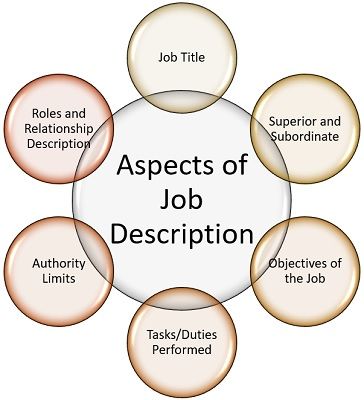Definition: Job Description is a written document which describes the job in the organization, on the basis of the data collected from the job analysis.
It covers the job contents such as the roles, responsibilities, scope, working conditions, hazards, location, purpose, duties and tasks of the position in addition to the job title, job summary, designation of the superior (i.e. immediate boss), as well as the expectations of the organization from the incumbent.
Job analysis refers to the process of gathering facts related to the job. This information and facts collected are then documented clearly, correctly and concisely in a statement, called a job description.
Aspects of Job Description
- Job Title: It is a brief account of what the job demands.
- Superior and Subordinates: It outlines the immediate boss of the job holder, i.e. to whom the incumbent should report, functionally and administratively. Further, it also highlights the immediate level subordinates, who reports to the incumbent for their tasks.
- Objective of the Job: It is basically the summary of the position, which describes the general nature, objectives, and purpose of the job to the job holder.
- Tasks/Duties Performed: It covers the list of all the tasks, duties, responsibility and accountability of the incumbent, which are relevant to the satisfactory performance of the job. The tasks and functions are listed out in the order of their importance, i.e. the most important function is listed out first, which is followed by the next important and the like.
- Roles and Relationship Description: It entails the position held by the occupant within the organization, that covers all the supervisory and subordinate roles and relationship with the co-workers and colleagues.
- Authority Limits: Every job has certain limits, which are termed as authority limits, which describes when the decisions are to be taken with prior approval of the superiors.
Job Description serves as the basis for job specification. At the time of recruitment, the job description is prepared so as to inform the candidates about the job profile and the job requirements accurately.
Uses of Job Description
- Communication between Supervisor and Employee: Job Description highlights the overall work profile of the incumbent, which he/she is expected to perform. So, it is of utmost importance for both the superior and subordinate for effective communication between them.
- Human Resource Functions: Job Description has a great role to play in the process of recruitment, selection, training, promotion and transfer to determine the knowledge, skills and abilities, to carry out the tasks accordingly.
- Performace Appraisal: At the time of performance appraisal, job description serves as a yardstick to gauge the performance of the incumbents, by checking whether the duties and responsibilities listed out in the document are carried out successfully or not.
- Human Resource Planning: It ascertains how many and what sort of human resource is required, and to what extent training is to be imparted to perform the job timely and effectively.
- Remuneration: Job Description helps to determine the salary or wage for every job, from the tasks and duties performed, responsibilities and authorities it possesses, as the remuneration must be paid according to the worth of each position in the organisation.
Besides this, job description also identifies any hazardous conditions or threats in the job, so that those who are willing and capable of performing the job are staffed.


Leave a Reply